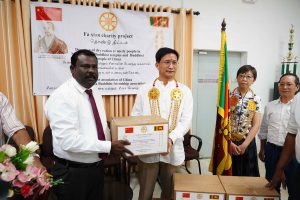Amidst growing Indian and American investments in Sri Lanka’s infrastructure sector, China seems to be taking a distinct and cost-effective approach that resonates well with the Sri Lankan people. This novel strategy has significantly countered the surge in anti-China sentiment that was evident in 2022, amid the economic crisis in Sri Lanka.
Over the past 18 months, India has extended over $4 billion in assistance to Sri Lanka. Concurrently, the Adani Group has invested nearly a billion dollars in the island. In September 2021, Adani Ports signed a $700-million deal with the Sri Lanka Ports Authority (SLPA) and Sri Lankan conglomerate John Keells Holdings to jointly develop Colombo Port’s West Container Terminal (WCT). Earlier this year, Sri Lanka approved a $442-million wind power project to be developed by Adani Green Energy, barely a month after the Indian conglomerate’s stocks plummeted following U.S.-based short-seller Hindenburg’s damaging report on the group.
A few weeks ago, the U.S. International Development Finance Corporation (DFC) agreed to provide funding of $553 million to develop the WCT. Addressing a press conference in Colombo on November 7, DFC’s Chief Executive Officer Scott Nathan said they seek to drive private sector investments that “advance development and economic growth while strengthening the strategic positions of our partners.” The DFC has pledged $1 billion to Sri Lanka, the second-highest in the region, following India.
In contrast, China’s only prominent investment in this period involved $392 million in the China Merchants Port Holdings-led South Asia Commercial and Logistics Hub (SACL) at Colombo Port.
Rather than matching U.S. and Indian investments, China has prioritized direct donations, aimed at winning the hearts and minds of the Sri Lankan people.
And the average Sri Lankan can do with all the help they can get.
According to UNICEF, as of May 2023, approximately 3.9 million individuals in Sri Lanka were experiencing moderate food insecurity, while more than 10,000 households were grappling with severe food shortages. Among them, over 2.9 million children require urgent humanitarian support to access essential services including nutrition, healthcare, education, water, sanitation, protection, and social welfare.
Over the past few weeks, the China Foundation for Rural Development (CFRD) has initiated its Smiling Children Food Package Project, delivering dry rations to 10,000 Sri Lankan students across 142 schools. CFRD, a non-governmental organization focusing on humanitarian aid and poverty alleviation, operates the International Smiling Children Project across several countries, including Ethiopia, Sudan, Nepal, and Myanmar.
Between November 5 and 7, Chinese Ambassador Qi Zhenhong took charge of distributing 5,000 boxes of dry rations valued at around $113,000 as part of the Faxian Charity Project. These donations directly support families in need in the districts of Jaffna, Vavuniya, Mullaitivu, Kilinochchi and Mannar. The distribution of dry rations which was done in district secretariats and religious sites benefited numerous locals.
According to Tabita Rosendel Ebbesen, a PhD student from Lund University, Sweden, who researches the role of China’s state-owned enterprises (SOEs) in port projects in Sri Lanka and China, “The past ten years have been a steep learning curve for China.” It has recognized that many of its initiatives, including the Belt and Road Initiative, have been heavily criticized, and that in the future, it should work towards mitigating or addressing criticism directly and indirectly. “China is working hard to promote itself and its pursuits through a more benevolent lens and Chinese officials at all levels of the system have been called upon to do their part,” she told The Diplomat.
Ebbesen drew attention to the “significant increase” in Chinese public diplomacy efforts lately. In the case of Sri Lanka, the Faxian Charity Project, named after the Chinese Buddhist monk Fa Xian who visited Sri Lanka in the 4th century CE, has been actively distributing food rations and offering aid since 2022.
These Chinese projects and efforts could not only benefit local communities but also have positive spill-over effects on China’s international reputation in the long run. “We can expect the West and other major powers like India and Japan that have strategic interests in Sri Lanka to scrutinize the Chinese efforts, Ebbesen said, adding that “only time will tell how they will attempt to match China’s soft power efforts, as well as how this will be perceived by the Sri Lankan stakeholders—politicians and the public alike.”
Led by Ambassador Qi, the CFRD initiatives are aimed at responding to criticism of Chinese initiatives like BRI and softening its image through benevolent actions. Qi has been instrumental in orchestrating donations and fostering people-to-people collaborations to promote China’s goals in the region.
The direct impact of China’s distribution of food aid on the lives of Sri Lankans cannot be overstated. These targeted aid efforts, though smaller in scale financially than the American and Indian investment in Sri Lanka, serve as a lifeline for those facing dire circumstances.
The ensuing positive effects on China’s international reputation and on Sri Lanka’s perception of China’s soft power strategies will undoubtedly be closely monitored by global stakeholders in the region. Ultimately, this shift reflects China’s evolving diplomatic strategies and its quest to establish a more benevolent global image.

































